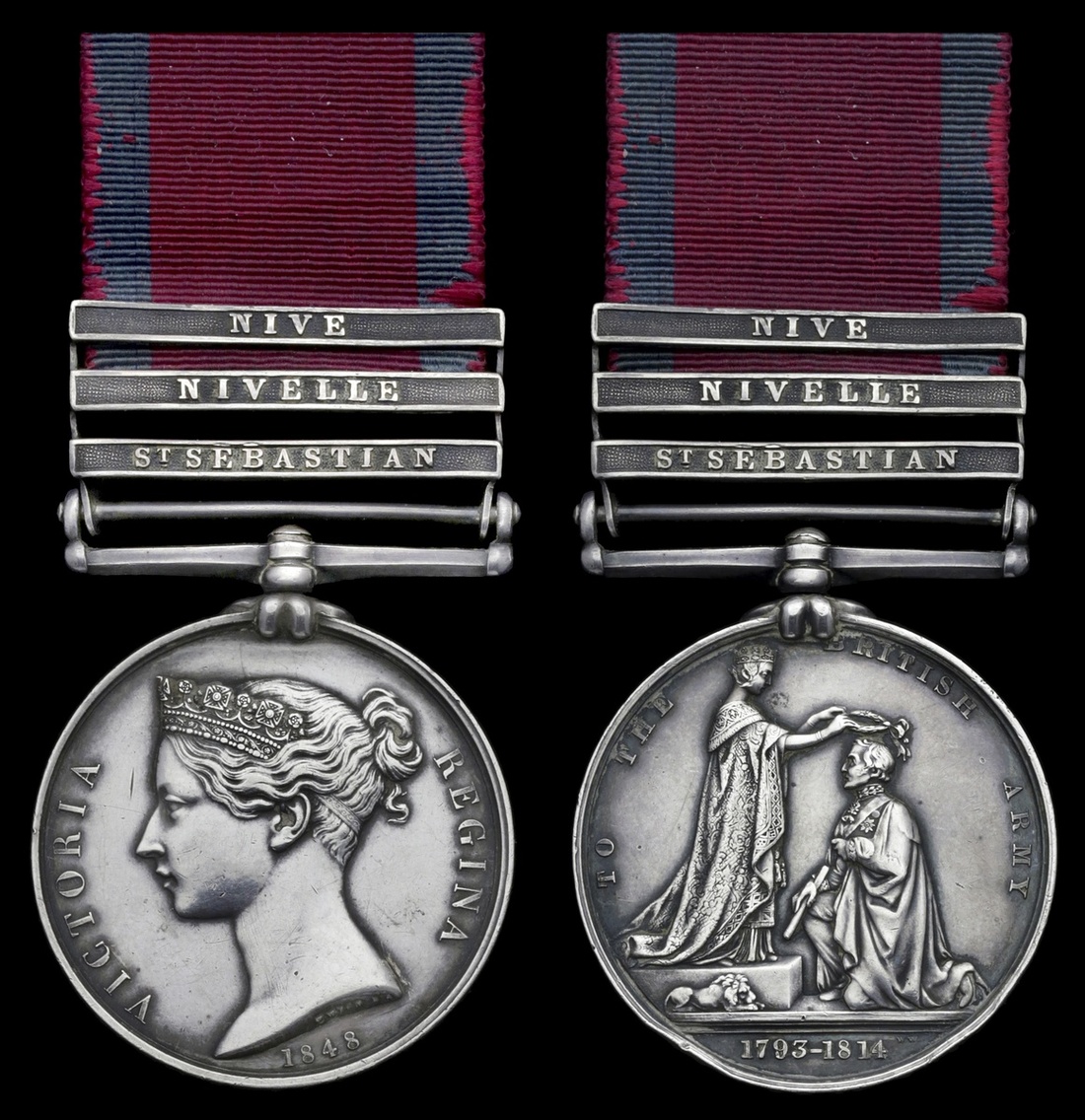
Auction: 20002 - Orders, Decorations, Medals & Space Exploration
Lot: 15
Military General Service 1793-1814, 3 clasps, St. Sebastian, Nivelle, Nive (John Sutton, 1st Foot Gds.), edge bruise, very fine
John Sutton was born at Willaston, Wiral at the end of the 1780s and enlisted in the 3rd Battalion, 1st Foot Guards on 7 December 1808. Upon enlistment he had already seen three years of service with the 5th Foot. Sutton joined the Regiment shortly after its return from Corunna and was soon in the number sent for the Walcheren Expedition. His unit was in Lieutenant-General John Hope's Reserve who landed between Wilmenduye and Cattendyke around noon of 1 August 1809. They soon marched up and captured Batz after Major-General Brues withdrew his forces. It was a small slice of good luck for the allies, who then found themselves ravaged by disease when the sluice gates were opened. Advancing and taking Flushing, the force were soon running low on objectives with it being clear that taking Antwerp was impractical. They embarked for England before the year was out and - remarkably - 11,513 men were still on the sick lists in early 1810.
Returned to Spain in April 1811, Sutton was next in action during the Siege of Cadiz and thence at the capture of Seville, following Marshal Soult's withdrawal. In the attack on Seville, the 1st Foot Guards supported in the leading attack and then joined in the capture of the city gates under fire of grapeshot and musketry. They also had the honour - together with some Spanish troops - in leading the column that crossed the bridge to the city, clearing all the French in their way (London Gazette, 23 September 1812 refers).
At St Sebastian, Sutton volunteered for the storming of the fortress and would have been part of the party that stormed the breach after the heavy artillery had created an entrance (Clasp). That action in some sources is indicated as towards 75% for the Guards Division.
Having also shared in the actions at Nivelle and Nive, the Guards then joined in the passage of the Ardour in 1814 and shared in the capture of Bayonne on 14 April. In that final battle they had come under heavy cannon fire whilst moving down the Great Bayonne Road in the approach and then turned the tables on the French when it seemed all might have been lost.
The Guards remained in France until 23 July and eventually landed back in London on 10 August. The respite didn't last long for once news came that Napoleon had escaped Elba, the regiment were mustered for service in Belgium. Departing for Ostend on 9 April 1815 they were organised into two Brigades, the 3rd Battalion forming part of Maitland's 1st Brigade. When news of the rapid advance of Napoleon's Army arrived at the Duchess of Richmond's Ball late on 15 June, the race was on. It was known that French troops were just a few miles from the crossroads at Quatre Bras, south of Waterloo. Whilst the 2nd Battalion were mobilised swiftly, the 3rd Battalion were more dispersed but were ready to march at 3am. Issued with ammunition and provisions, they set off for action. Taking a short rest at Braine-le-Comte, they made the field and found that the French held the strategically important Bossu Wood, whilst streams of wounded Belgian troops came back the other way. Entering the wood the Guards came under a murderous fire, facing three French Battalions and two guns. Sutton was wounded by gunshot to the breast and arm in the battle. The unit thence distinguished themselves on the field of Waterloo two days later. Sutton remained in France until August and was discharged in November 1816, becoming a blacksmith. Residing at Burwardsley, Cheshire, he was the village blacksmith from 1841-71 and died in 1879; sold together with a detailed file of researching including muster roll extracts.
Subject to 20% VAT on Buyer’s Premium. For more information please view Terms and Conditions for Buyers.
Sold for
£1,000
Starting price
£600




